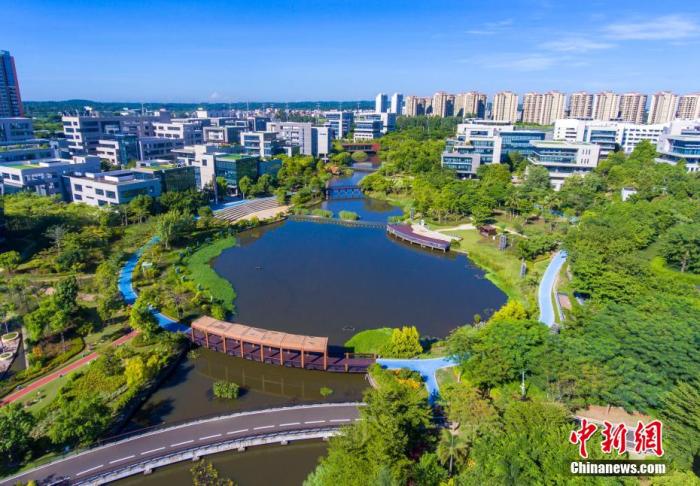(Economic Observation) Hainan Free Trade Port meets the world's largest free trade zone: RCEP brings more open dividends
China News Service, Haikou, January 4 (Reporter Wang Ziqian) The "Regional Comprehensive Economic Partnership Agreement" (RCEP) came into effect on January 1, 2022, marking the landing of the world's largest free trade zone.
At present, Hainan is building a free trade port with Chinese characteristics, and both are committed to high-level opening. What kind of sparks will the two meet?
Many experts recently interviewed a reporter from China News Agency and pointed out that after the RCEP takes effect, Hainan Free Trade Port has more opportunities than challenges, resulting in policy stacking effects and stimulating more open dividends.
Data map: Aerial photography of Hainan Ecological Software Park.
Photo by Luo Yunfei
RCEP and Hainan Free Trade Port have complementary advantages
Zhao Jinping, former director of the Foreign Economic Research Department of the Development Research Center of the State Council of China, said that RCEP and Hainan Free Trade Port’s Chinese expression are both "free trade zones", but RCEP is a free trade agreement (FTA), and Hainan Free Trade Port is a free trade zone ( FTZ), the two set goals to promote trade and investment liberalization and facilitation, but they have different connotations.
Chen Bo, professor of the School of Economics at Huazhong University of Science and Technology and Dean of the Optics Valley Free Trade Research Institute, explained the difference: From the perspective of initiative, the Hainan Free Trade Port is an active one-way opening, and RCEP is a reciprocal opening between member states; from the perspective of scope, The opening of Hainan Free Trade Port is not limited to RCEP, but to the world; from the perspective of strength, Hainan Free Trade Port is built in accordance with the highest level of openness in the world, with a higher degree of openness.
"After the RCEP takes effect, the Hainan Free Trade Port will gain opening opportunities from relevant member states." According to Bai Ming, deputy director of the International Market Research Institute of the Institute of International Trade and Economic Cooperation of the Ministry of Commerce of China, the effective RCEP does not have a negative impact on Hainan.
From the perspective of trade in goods, Hainan not only reduces tariffs, but also reduces import value-added tax and consumption tax. It still has a tax advantage. In the field of service trade, Hainan has issued China’s first cross-border service trade negative list, and has the ability to accelerate the development of service trade and expand the market. Important time window for opening.
Chi Fulin, Dean of the China (Hainan) Reform and Development Research Institute, said that the effective RCEP will strengthen Hainan’s location advantages and provide an opportunity for Hainan Free Trade Port to build an ASEAN-oriented industrial chain supply chain.
He noted that Hainan has become China’s only ternary supply chain (domestic supply chain, RCEP intra-regional supply chain, and out-of-region supply chain) that can achieve “zero tariffs”, which is important for enriching Hainan’s industrial structure, promoting industrial upgrading, It is meaningful to stabilize the regional layout of the supply chain.
Data Map: Aerial photography of Haikou Meilan International Airport Phase II Expansion Project.
(Drone photo) Photo by China News Agency reporter Luo Yunfei
"RCEP+Hainan Free Trade Port" Welcome Machine
"RCEP will drive the rapid growth of regional flow of people, logistics, capital, and information." Yu Tao, director of the Hainan Free Trade Port Research Center of the China South China Sea Research Institute, said that Hainan's geographic advantages help to become a regional aviation and maritime hub.
The entry into force of RCEP can promote Hainan and ASEAN to seek pragmatic cooperation in low-sensitive areas such as blue carbon, marine environmental protection, and maritime search and rescue.
Ni Yueju, a researcher at the Institute of World Economics and Politics of the Chinese Academy of Social Sciences, said that the entry into force of RCEP marks the first time that China, Japan and South Korea have been linked together through a trade agreement in Northeast Asia. Hainan’s commodities facilitate the entry of Japan and South Korea, and at the same time, it is convenient for the enterprises of the two countries to deploy in Hainan and take advantage of policy stacking. Advantages to expand the value chain.
"The Hainan Free Trade Port has a unique position in China's opening up process. It will not be weakened by RCEP, but an important experimental field and pointer for China to further open up." Chen Bo pointed out that Hainan Free Trade Port has a higher opening than RCEP. Advantages, through institutional opening, there is plenty of room for regional industrial chain restructuring, financial innovation, digital economic cooperation, and personnel mobility.
Zhao Jinping suggested that Hainan should make full use of the zero-tariff advantage of the free trade port to enhance industrial competitiveness, promote investment liberalization and facilitation with the negative list system as the core, and accelerate the flow of innovation in service elements.
Bai Ming reminded Hainan to actively seek high-level opening up, find the difference between the opening of the free trade port and the opening of RCEP, and make up for the shortcomings as soon as possible.
(Finish)

